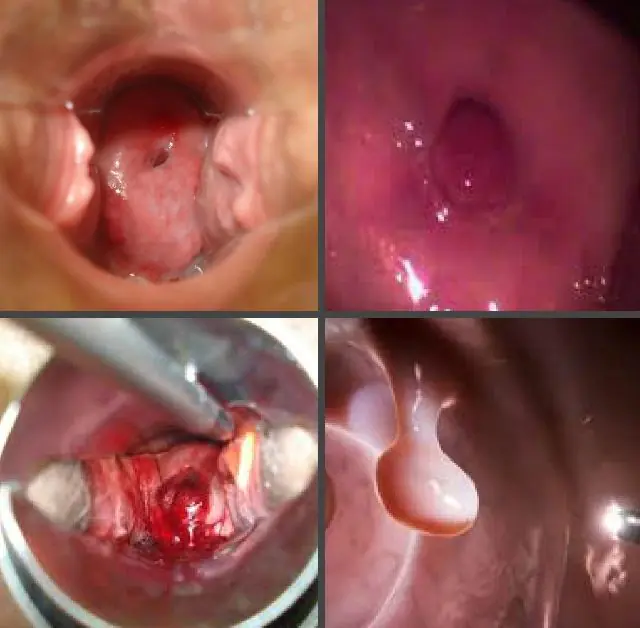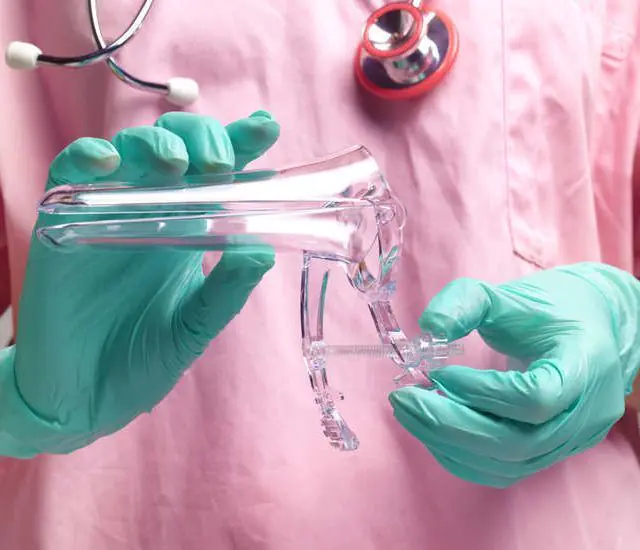
- Reasons for appearance
- What does cervical canal papilloma look like?
- Treatment methods
- Removal of papillomas
- Medicines
- Folk remedies
Papilloma of the cervical canal is a serious pathology of the reproductive system of the female body, characterized by the growth of benign growths on the walls of the duct between the vagina and uterus. The appearance of such formations is provoked by the human papillomavirus. The disease can cause a number of serious complications, including cervical cancer. In this regard, it is very important to promptly recognize the disease, determine the strain of the pathogenic microorganism and begin immediate treatment.
Causes of cervical canal papilloma

The appearance of various types of papillomas in humans is associated with infection with the multifaceted human papillomavirus. The pathogenic microorganism, when it gets on the skin or mucous membranes, quickly takes root, but does not begin to show its activity immediately. Sometimes a month passes, and sometimes several years until the moment when the pathogen reveals itself by external manifestations, which are benign formations in various parts of the body, for example, papillomas of the cervical canal in the cervix.
The methods of infection with HPV are as follows:
- intimate contact. The main route of infection is sexual contact with an infected person. This can be traditional sex, oral-genital, anal and petting. It is worth considering that this method of contraception, such as using a condom, does not protect against HPV at all, although it reduces the risks.
- Autoinfection. For the virus, one touch and the slightest microcrack in the epithelium are enough, through which it penetrates deep and integrates into a healthy cell. Sometimes self-infection occurs when a person transfers a microorganism from one part of the body to another, including the intimate area. This provokes the migration of the microorganism into the vagina and cervix, which is why papillomas of the cervical canal appear.
- Contact and household. Less often, infection occurs through household contact, when the virus is transmitted between household members. This occurs under the condition of sharing some personal items, reduced hygiene and close contact with the skin - kissing, hugging, massage, etc. Potentially dangerous in terms of contact infection are public places with high humidity, where the virus can survive for a short time outside the human body . So, you should be careful when visiting swimming pools, public baths, locker rooms in sports institutions, and public transport.
- At birth. There have been cases of infection of a child during childbirth with the presence of HPV in the birth canal.
In order for papillomas of the cervical canal to appear due to HPV, as well as growths in other parts of the body, the onset of special conditions favorable for the virus must occur. The most important thing is a significant weakening of general immunity, when the body does not produce a sufficient number of immune cells capable of containing the pathogen.
The main reason for the activation of the human papillomavirus and the beginning of the growth of pathological growths - a decrease in immune defense - has several predisposing factors, namely:
- Untreated diseases. Any disease can reduce the body's protective functions. First of all, disturbances in the functioning of the central and peripheral immune system are dangerous. Risk factors include the presence of HIV, diabetes, and hormonal imbalances. An increased risk is observed in diseases of the genitourinary system, which include a number of sexually transmitted pathologies (chlamydia, syphilis, herpes, etc.), and microflora disorders. They quite often contribute to the growth of papillomas of the cervical canal.
- Taking medications. Uncontrolled antibiotics, hormonal agents and other potent medications can have a strong impact on the body's ability to resist infection.
- Poor environment, bad habits, unhealthy diet. Environmental pollution, the harmful effects of alcohol, tobacco smoke, unbalanced nutrition - all this negatively affects the functionality of the entire body, including the immune system. Air pollution and tobacco smoking provoke not only the growth of cervical canal papilloma, but also more serious disorders - the development of the oncological process.
- Insufficient physical activity, improper work and rest schedule, stress. These factors provoke a disruption in the functioning of the entire body, deplete it, causing a lack of nutrients, the development of concomitant diseases, opening the way for pathological microorganisms.
- Hectic lifestyle. This includes early onset of sexual activity, intimate relationships with different men, early pregnancy and childbirth, abortions, miscarriages.
See also the causes of papilloma in the urethra in women.
What does cervical canal papilloma look like?

Photo of papillomas of the cervical canal
It is impossible to independently determine the presence of cervical canal papilloma due to the localization of the affected area inaccessible to visual inspection and palpation. A gynecologist can take a photo of a papilloma of the cervical canal during a colposcopy if the growths are located on the external os of the cervix. There are also special devices for examining the uterine cavity, at the end of which a light bulb and a camera are attached.
The set of diagnostic procedures includes:
- Blood test for inflammatory processes, viral load and pathogen strain, as well as for possible concomitant diseases (HPV, syphilis, hepatitis);
- Vaginal smear for microflora;
- Urine analysis for pathologies of the urinary system;
- PCR testing;
- Biopsy of tissue growths;
- Scraping for oncocytology.
There are both single and multiple colonies of papillomas inside the endocervix. The color range is not wide: benign papillomas can be the same color as the endometrium, light pink, dark brown, brown-violet or reddish.
Types of papillomas of the cervical canal:
- Condylomas acuminata. They look like cauliflower sprigs or cockscombs. The density of pointed villi can vary - from single to multiple formations.
- Flat papillomas. They practically do not protrude over the epithelium; they grow as if inward. Because of this, their diagnosis and treatment become significantly more complicated. Their structure is dense, but the surface is smooth.
The effect of the virus does not cause an increase in body temperature, general intoxication or other obvious signs. You can suspect the appearance of papillomas of the cervical canal by the following symptoms:
- Suspicious vaginal discharge, microflora disturbance with an unpleasant odor;
- Pain in the intimate parts of the body with increased physical activity or during sexual intercourse;
- Bloody discharge that appears after intimacy;
- Menstrual irregularities;
- Deterioration in health.
The absence of these symptoms is not a sign of absolute health, because... Papillomas themselves do not cause pain or any discomfort.
Many patients, having heard that such growths are eliminated using invasive methods, are interested in whether it is necessary to remove papillomas of the cervical canal or whether it is possible to do without radical measures. This question can be answered by understanding what risks are associated with the presence of these tumors. In fact, the danger of cervical canal papillomas is quite multifaceted, and the negative consequences of this disease include:
- Development of pathological microflora. The cervical canal is the site of mucous formation and bloody discharge passes through it during menstruation. This duct is characterized by high humidity, so there is a high risk of developing pathogenic microflora and the addition of concomitant infections, which can complicate the course of HPV and provoke the growth of papillomas of the cervical canal to nearby areas. The situation is complicated by promiscuous sexual relations, as a result of which one can become infected with sexually transmitted diseases and acquire HIV.
- Impaired fertility. It is worth understanding that the cervical canal plays an important role in the reproductive function of the female body, because sperm enter the uterus through it during ovulation, and the birth of a child occurs at the appointed hour. The presence of papilloma in this area provokes a narrowing of the passage with subsequent obstruction. This leads to the development of infertility. The negative impact of growths that appear during pregnancy can cause miscarriage.
- Development of malignant tumors. HPV can trigger the development of cervical intraepithelial neoplasia, a precancerous condition. Under certain conditions, papilloma cells of the cervical canal and vagina can degenerate into malignant ones, which, if not treated in a timely manner, can lead to death.
Due to the existing risks, removal of papillomas in the cervical canal is a mandatory part of complex treatment.
In order not to waste time, you need to visit a gynecologist twice a year. And if you suspect an HPV infection, you should also contact a dermatovenerologist. Sometimes additional consultation with an immunologist, oncologist, or endocrinologist is required.
Methods for treating cervical canal papilloma
Despite the fact that removal of papillomas in the cervical canal is considered mandatory, do not forget that this will not affect the overall viral load and the degree of virus activity, and without proper drug therapy, the growths will reappear. That is why the treatment of such a disease should be carried out in a complex, and along with the destruction of benign formations, antiviral and immunomodulating drugs, as well as vitamin and mineral complexes, should be prescribed.
Removal of papillomas in the cervical canal

In world medical practice, there is still no uniform treatment regimen for cervical canal papilloma, so doctors choose the most appropriate tumor destruction methods and medications in each individual case.
There are many options for removing growths, but not all of them, due to the inaccessibility of the affected area, can be used to destroy papillomas of the cervical canal. Moreover, each of them has both advantages and disadvantages.
The most popular methods for removing papillomas in the cervical canal are the following:
- Broadband radio wave surgery. Influenced by high-frequency radio waves. Using a loop electrode, the tumor is excised. At the same time, the blood vessels are fused, which reduces the risk of bleeding. This option allows you to take samples of papilloma of the cervical canal for analysis, is characterized by low trauma to cervical tissue and relatively rapid healing without the formation of rough scars. Excellent for the treatment of HPV localized in the cervix of nulliparous women or women planning pregnancy. The cost of the procedure is from 2000 rubles (from 700 hryvnia).
- Argon plasma coagulation. This method of monopolar high-frequency surgery uses electromagnetic field energy transmitted to the affected tissue using argon. The action is heating of neoplasm cells followed by evaporation. The method is characterized by high precision, virtually eliminates damage to healthy tissue, and is characterized by rapid recovery. It does not harm healthy tissue of the cervix, therefore it is often used to treat nulliparous women and those planning a second pregnancy. The price of the procedure is from 500 rubles (300 hryvnia).
- Electrical destruction. High-frequency electric current is directed to the papilloma of the cervical canal, exerting a temperature effect and causing charring of the growth. Bleeding is not observed, because the action of the device causes simultaneous sealing of the vessels. Among the difficulties of implementation is inaccessibility when localized closer to the internal pharynx. Price - from 1000 rubles (from 300 hryvnia).
- Laser coagulation. A fairly popular method of instrumental surgery. The procedure lasts about 15 minutes. The duration of the recovery period rarely exceeds 14 days. The cost in Russian clinics is from 1000 rubles, in medical institutions in Ukraine - from 400 hryvnia.
- Cryodestruction. During the manipulation process, pathological cells are frozen using liquid nitrogen. The method is characterized by poorly controlled penetration depth when removing papilloma in the cervical canal, which can lead to injury to healthy tissue with subsequent disruption of the structure of the cervix. The cost of removal is 400 rubles or 220 hryvnia.
- Surgical removal. It is aimed at excision of the tumor and surrounding tissues using a surgical scalpel. During the procedure, blood vessels are affected, which causes minor bleeding. Scars remain. The healing period is the longest compared to other methods. The tissue of the cervix can become deformed, which impairs the elasticity of the endocervix and can subsequently negatively affect reproductive function. This method of removing papilloma in the cervical canal is highly not recommended for the treatment of nulliparous women. Price - from 500 rubles (300 hryvnia).
- Chemical destruction. This method is used if there are contraindications to others. It is carried out through the burning effect of nitric acids. The procedure should be carried out exclusively by a qualified specialist to avoid burns to healthy cells. Price - from 1000 rubles (600 hryvnia).
After the procedure of instrumental excision of cervical canal papilloma, periodic visits to the gynecologist for a preventive examination or active screening at certain intervals are most often indicated to detect relapse in the early stages and prevent the development of cervical cancer. Also among effective diagnostic methods are colposcopy, determination of viral load and cytology smear.
Treatment of cervical canal papilloma with medications

In the photo are preparations for cervical canal papillomas
None of the instrumental methods guarantees that papillomas of the cervical canal will not appear again, because removing growths is, in fact, eliminating the symptom of the disease, or more precisely, the external manifestation of HPV. In this case, the microorganism itself is securely integrated into the cells of the body. But it is quite possible for modern medicine to reduce the viral load and lull the activity of the pathogen for a long time. This is done with the help of drug therapy by increasing the human immune defense and directly combating the pathogen.
In the treatment of HPV and to prevent recurrence of cervical papilloma in the cervix, the following medications are often used:
- Allokin-alpha. Highly effective antiviral agent. Has a strong immunostimulating effect. Safe for human wearers. The minimum course of treatment includes 6 injections, the cost is about 7,400 rubles or 4,000 hryvnia.
- Alpirazine. It has an antiviral effect on HPV, suppresses the reproduction of the microorganism in the early stages of its development. Promotes the production of interferon gamma. Along with this, it has a bacteriostatic effect. Price - about 180 rubles or 120 hryvnia.
- Viferon. Supplies interferon-alpha-2b into the body. Increases the body's immune defense, suppresses the activity of the virus. The price of candles is from 270 rubles (180 hryvnia).
- Genferon. If cervical canal papilloma is diagnosed, the attending physician may prescribe this drug in the form of suppositories. The medication has an anti-inflammatory effect, kills background bacteria, and helps transform the immune defense at the local level to more effectively combat the human papillomavirus. Costs from 400 rubles or 250 hryvnia.
- Panavir. It has a complex effect - immunostimulating and antiviral. The drug is able to reduce the growth rate of tumors, preventing the growth of the affected area. The price of the minimum course of treatment for cervical canal papilloma with intramuscular administration is 1600 rubles or 900 hryvnia.
- Other drugs. Isoprinosine, kipferon, neovir, reaferon, cidofovir, condiline, fluorouracil, etc.
At the discretion of the gynecologist, according to indications, specific hormone therapy can be prescribed, which will normalize tissue regeneration and restore the functionality of the entire reproductive system. Sometimes vitamin and mineral complexes are also included in the prescription list.
Folk remedies for the treatment of cervical canal papilloma

Folk remedies should not be used as the only method of treating cervical canal papilloma, because they are ineffective and often simply waste time. As a result, there are high mortality rates from cervical cancer among those women who did not seek qualified medical help in time.
Available remedies, herbal decoctions and homemade tinctures can only be used as an auxiliary therapy aimed at improving the general condition of the body, increasing immunity and replenishing the deficiency of nutrients.
Health benefits that can be used to enhance immune defense during the treatment of cervical papilloma include celandine, lemon or potato juice, garlic, dandelion root, nettle, plantain, lemon balm, horsetail, St. John's wort, ginseng and much more.
To prevent the development of the infectious process and protect yourself from the consequences of cervical canal papilloma in the cervix, and your sexual partner from infection, you need to take simple preventive measures:
- Improve body hygiene and give up promiscuous sex life;
- Normalize your lifestyle by giving up bad habits, dangerous foods and enriching your daily diet with healthy foods;
- Treat all emerging diseases in a timely manner and refrain from self-medication;
- Increase physical activity.
Read also recipes for folk remedies for papillomas in intimate places.
Cervical cancer is a fairly common dangerous disease that very often leads to death. To avoid the most undesirable consequences, every woman should be attentive to her health and not neglect the achievements of modern medicine, which can reduce the incidence rate and significantly improve the quality of life and its duration.
- Related article: Which doctor treats papillomas in intimate places



